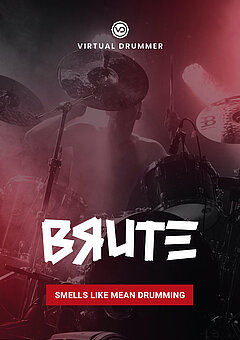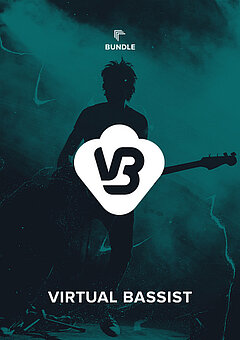Slap Bass Secrets for Rock Music
How to nail the perfect bassline for hard-hitting rock songs using virtual instruments (no live players required).
MAY 21ST, 2022
In rock music, the most valuable thing you can do is to keep the right vibe! Read until the end of this article to learn how to master bass slaps in rock music:
Constructing the perfect bassline
First, we’ll address the creation of bass parts from scratch. When in doubt, find a rhythm you like on the bass and make sure it complements the drum pattern well. Syncopate it, repeat it, add in rapid 16ths, doesn’t matter — since you’re not changing pitch, this frees up more mental bandwidth for you to experiment! The slap bass’s twang is what makes this approach work so well, lending you a whole new dimension to play with. Get a good groove going, record it into your DAW and add in some drums to lock it in. Then you’re free to begin changing notes within the rhythm, building out the song and allowing it to develop. When you tackle the rhythm first, you might find that the notes come to you naturally, making this a great way to start.
If you use Virtual Bassist SLAP, the process becomes even simpler. Start with one of the Style Phrases to get some activity going, then once you find something close enough, use MIDI Drag & Drop to pull the phrase into your DAW session and tweak the notes to your liking. The greatest benefit here is the pre-programmed rhythms; the actual notes can easily be changed to keep the right vibe while hitting the chords you need. Something to play with: don’t always play the root note of a chord. Experiment with using the bass to stay on 3rds and 5ths on occasion, and you’ll immediately create a more complex and professional sound.
Fun note: if you do everything in the box (no live players), you have an advantage that’s fun to play with: your “musicians” aren’t limited by tempo or playing technique. If you want to make an intense rock track at 240bpm, it might be unplayable, but you can still create a finished track!
Creating realism
Here’s where things get tricky — when every note from your virtual bassist is slapped hard, you run the risk of your music sounding comical. This becomes even more pronounced when the VST isn’t multi-sampled (multiple samples of the same note recorded at different intensities), and the bass will quickly take on a fake, mechanical quality. The solution is to use a VST that can handle all the above gracefully (or to get your hands dirty with a lot of manual work!).
SLAP is the perfect all-around solution, with realistic and editable MIDI loops to get you started so you’re simply tweaking, rather than starting from scratch. One of the key components behind SLAP’s realism is that it can effortlessly switch between fingered and slapped notes, creating a natural feel that otherwise you can only get from a highly skilled live player! You can assign the finger vs. slap setting to a MIDI CC or automate it in your DAW session, allowing you to have slap bass in one section and fingered in another.
With rock and metal, there’s a fun trick you can use to tie your virtual band together. When the kick and bass play in a unified rhythm, you get an incredible punchy result that’s hard to replicate otherwise. Fast, syncopated rhythms are a great opportunity for this, as long as it isn’t overused — and because everything is sequenced, you can manipulate the note timing of the instruments however you like! Power metal is a great playground for this. Try laying down a drum part with Virtual Drummer BRUTE, dragging out a pattern with MIDI Drag & Drop, and having some fun with the kick timings. Then when you drop in the slap bass, do the same, matching it up with the drums. Drum fills between sections are an excellent time to try this out!
Mixing and production
If you’re reading this and you’re accustomed to mixing EDM, you probably know what’s coming next — yes, rock is very different. For starters, dynamics in rock are typically way less polished, and irregularity is one of its defining features. This means that you don’t want to over-compress your slap bass, as the natural volume contours are important to preserve. If you add a lot of distortion, you may not need any compression at all, as nearly all forms of distortion condense the dynamic range of any material you process.
Another aspect where rock differs is the high end. In EDM, you may want to create a ton of “air” by boosting high frequencies and aggressively cutting the mids and low mids. With rock, the same treatment would sound sterile and cheap. Instead, beef up the low mids appropriately and de-emphasize the top range (16kHz and above) in any instruments you need to. You also want to bring out the twang of the slap — emphasize the highs around 7kHz with a slight EQ boost if you think you need it. This frequency range sounds harsh in isolation, but if you set your levels correctly, something will still feel like it’s missing unless this range punches through a bit. Be careful when balancing the upper frequencies of slap bass vs. guitars!
Lastly, here’s an important note about bass frequencies: in rock, it’s easy for bass to overpower the mix. Most of the standard best practices for EDM bass mixing go out the window for rock music! The decrease in volume from low to high frequencies is way more subtle, and you do not want to “scoop out” the mids and low mids. The frequencies of instruments in a band arrangement will clash more, and that’s normal — strive for balance, rather than the merciless separation of instruments and frequency ranges you find in EDM.
Wrapping up
Slap bass is a valuable addition to any virtual ensemble, but something about the spirit of rock allows it to take on a uniquely raw and powerful character. The most important part is getting the bass, drums and guitars to all sit together, focusing especially on the relationship between the drum kit and bass to help your slapped notes punch through the mix. Experiment with alternating between slap and fingered bass, as not everything calls for such an intense high frequency vibration all the time.
With rock, the most valuable thing you can do is to keep the right vibe throughout, taking care not to overtreat the mix, allowing each instrument’s natural characteristics to come through. Have fun with it, and feel free to experiment with the unconventional! If you want the best tool for the job, look no further than Virtual Bassist SLAP — it’s the perfect tool to bring the flexibility and realism of a live player into a fully virtual ensemble.
About the Author
Harry Lodes is a copywriter, marketing consultant and content writer for audio and ecommerce brands. He lives in the Philadelphia area, releasing Eastern/Western hybrid EDM under the artist name KAIRI hearkening back to his roots in Berklee College of Music.
Stay up to date
Sign up and we’ll send you an e-mail with product news and helpful stuff every now and then. You may unsubscribe at any time.
Defy Limits
We develop software solutions that enable people to create, consume and interact with music.




